(Both The Girl and I are incredibly sad about the attack that occurred in Nice last night. Bastille Day – La fête nationale- is our favorite day of the year here in France, and is incredibly special on so many levels. It’s all about community and enjoying the day with not just friends and family, but also people you’ve never met. It’s as much about celebrating French unity as it is about celebrating your neighborhood and those around you. It breaks our heart to see what happened yesterday on such a special day in such a special place to so many innocent people.)
As regulars know, I take photos across pretty much all my activities…swim…bike…run…cake delivery…you name it! But there’s one activity that seems to cause the most confusion and questions: Openwater swimming.
Without fail, anytime I post a picture during an openwater swim (training or racing) I get a tidal wave of questions on what camera I use and where I put the camera. So I’m here to give you the answers. And given it’s a Friday, we’ll keep this semi-quick!
For years I’ve been taking photos during openwater swims, both training and racing. Typically for racing I usually take them at the very beginning right before the starting gun, and then again usually somewhere in T1 (Transition 1), running from the water to my bike rack. For training, it just depends on if I find something interesting along the way. However, my technique is largely the same.
First let’s talk cameras. I almost always use a GoPro Hero4 Silver. I do this for two reasons: First, is that it’s my favorite action cam. But second is that it has a screen. Oh, and third, it’s not so small that I’ll lose it fumbling around underwater (looking at you Hero4 Session).
In the past I’ve also used a number of small point and shoot cameras from the Pentax and Panasonic Lumix waterproof series. I find they actually tend to produce better individual photos than the GoPro’s do, but the GoPro gives me more versatility. In unrelated news, I ran over one of my last little Pentax cameras with a rental car in San Francisco. Actually, technically I didn’t run over it – but rather the car behind me did after it flew off my roof. I was merely an accessory.
Here’s a photo I took from one of the point and shoot ones camera during the Escape from Alcatraz triathlon:
Anyway, so the first step is using a waterproof camera that’s easy to utilize underwater. Next, remember to lick the camera lens. Seriously, lick it. It keeps the water droplets from pooling on it when above water, and is cheaper than buying anything designed for that purpose. It’s a well known trick of any frequent aquatic GoPro user. But to be clear: You’re licking the outside of the GoPro lens case, not the actual GoPro lens inside itself.
Next is finding a place for that camera while I’m actually swimming. I put the camera in precisely one of two spots. For swims with wetsuits, I simply slide the camera a few centimeters down the neckline of my wetsuit. This way it’s out of the way, but also easily grabbable. Here:
If the camera has a small strap on it, I’ll usually leave the strap hanging out of my wetsuit – simply to make it easier to grab. But I never really have issues with the cameras going anywhere, as my wetsuit is snug. If your wetsuit is so loose that your camera slides around, then…you need a new wetsuit.
What about non-wetsuit swims? For that I place it on the leg of my swimsuit (jammer or triathlon style). I find that jammer/tri style swimsuits are ideal for holding the camera. As long as the swimsuit is snug it’ll easily hold it. I just slide it a few inches up the swimsuit. This way I can easily feel for it on any swim stroke, since my hand goes right by my thigh.
For women without a wetsuit/trisuit…umm….I don’t have a great solution there. The Girl when wearing a one-piece has occasionally just placed it down the top and that’s held fairly well. And on a two-piece she’s used the little string on some cameras to just tie it on the side of the bottoms. Not ideal, but works in non-rough water. Perhaps you could use a simple SPIbelt and then just wear that if you wanted it along. That would keep it relatively streamlined.
Oh, and solving one last curiosity – one time I also tried putting a GoPro on my swim buoy, to try and capture both a time-lapse and live broadcast of the swim. I did this during a week long trip to Malta. Turns out that makes the swim buoy top heavy and then it flips over…giving you more of an underwater view. Plus, sticky mounts come off there near instantly. So you have to use a strap of some sort (I used a Polar HR strap and put the sticky mount on top of the transmitter pod). I’m sure someday I’ll try this method again.
So there ya have it – everything you ever wanted to know about how I take photos during openwater swims.
Thanks for reading, and have a great weekend!
(Note: I tend to keep this page here updated with all my photography gear…though, it looks like it needs a few items refreshed. Will get that knocked out today!)
FOUND THIS POST USEFUL? SUPPORT THE SITE!
Hopefully, you found this post useful. The website is really a labor of love, so please consider becoming a DC RAINMAKER Supporter. This gets you an ad-free experience, and access to our (mostly) bi-monthly behind-the-scenes video series of “Shed Talkin’”.
Support DCRainMaker - Shop on Amazon
Otherwise, perhaps consider using the below link if shopping on Amazon. As an Amazon Associate, I earn from qualifying purchases. It doesn’t cost you anything extra, but your purchases help support this website a lot. It could simply be buying toilet paper, or this pizza oven we use and love.

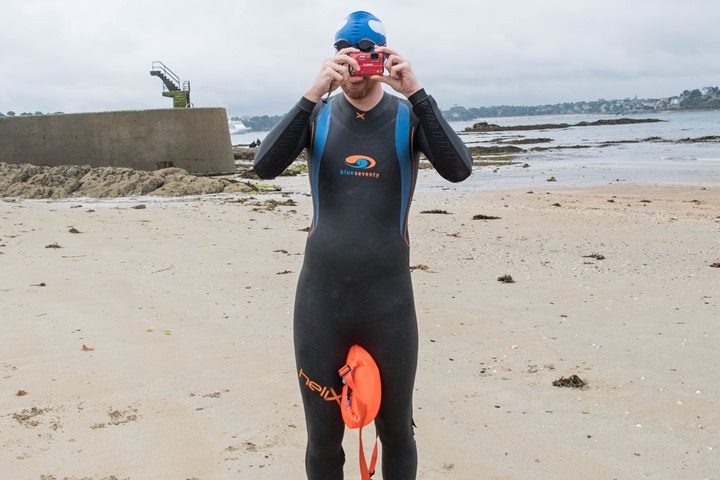
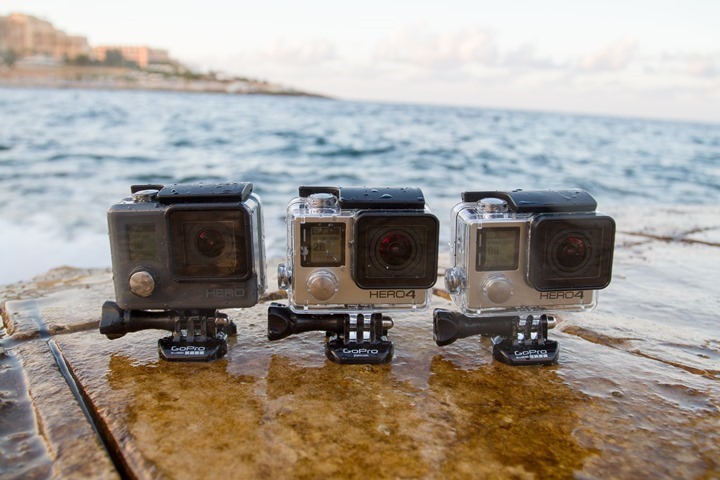
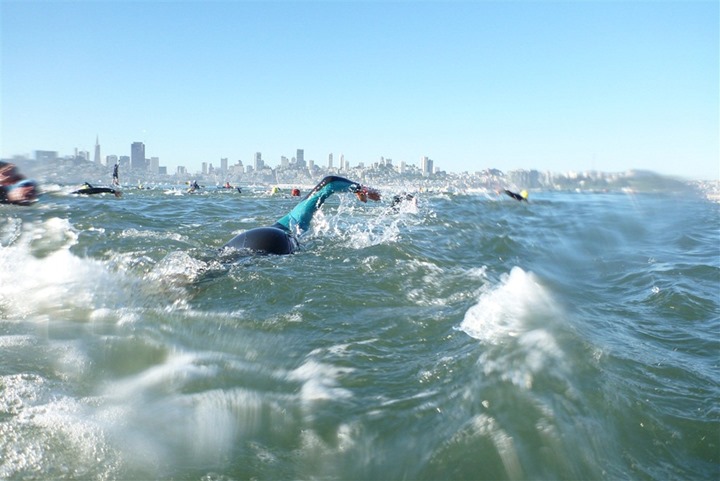
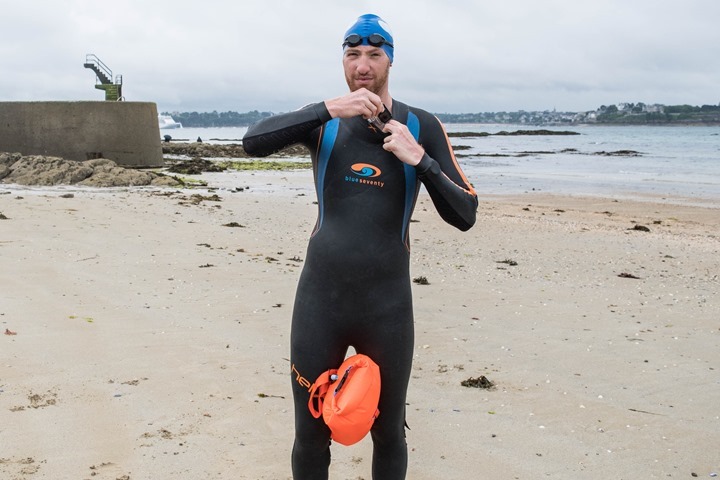
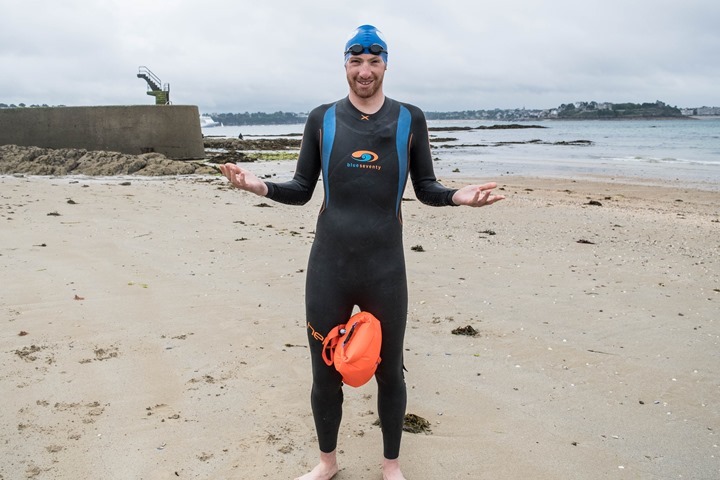


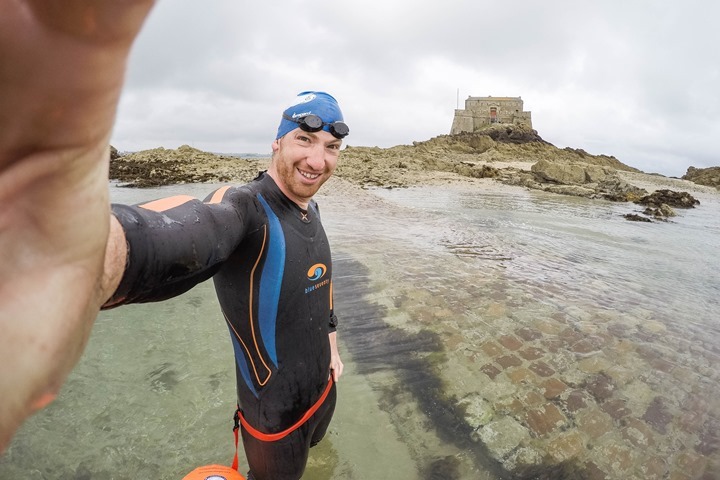



















Won’t the wetsuit get “damaged” (even slightly) when putting the camera there? Since GoPro’s are quite bulky, I can imagine if the neoprene is constantly bulking from the camera, it might diminish the quality of the suit?
Nope, never had problems with that. Plus, you’ll usually shift locations slightly (left side a bit, right side, center). And in most cases if you figure a wetsuit may get used at most 1-2 times a week in peak season for most athletes*, which is usually an hour or two compared to the other 166 hours of the week sitting there recovering…it’s all good. ;)
*Ok, most triathletes it’s probably 5-8 hours of wetsuit time per year…
Yeah good point, I see what you mean :P.
Ray, I used the same swim buoy as prescribed. I wanted to check my elbow, arm and head attitude in OWS. I anticipated the center of gravity issue and tossed in one lacrosse ball to act as ballast and a bit of a keel to help the buoy track more gracefully; It worked well. I may add another lacrosse ball in-line to prevent twisting left and right.
Anybody want to take a guess when a gopro compatible swim buoy will appear on Kickstarter? :-)
Thinking inbuilt mount and shaped or weighted underneath for balance
This guy has put in quite a bit of effort to create…. Frankenfish!
link to robaquatics.com
If you are going to put weight (camera) on top of a somewhat unstable object (swim buoy), you need ballast on the bottom, of greater weight than the top. This will cause drag and may be enough to submerge the buoy.
Thanks for posting this! See? I won’t have to bug you anymore with questions every time you post about open water photos ;)
As others have said… the swim buoy is kinda like the ‘balance a coin on the floating lemon’ funfair trick. As soon as you put the weight on the top, it spins over. So you have to counter it with something. As you will have the strap around the buoy already, just hang a bag of stone/sand from that underneath. Carry an empty plastic bag (tie-top style food bag maybe, or larger plastic bag with handles) then grab a handful of stones or sand from by the water. Thread the strap through the handles to hold it under the buoy and you should be good to go. The Gopro is very light, so you wont need much.
(oh, and to solve the lemon trick – press a heavier coin into the bottom of the lemon to counterbalance the smaller one on top. You may have to do this whilst the conman isn’t looking!).
Try a counterweight for the bottom of the swim buoy (on the same strap) to keep the camera above water. A one lb. SCUBA weight with “keepers” (i.e. tri-glides) will keep the weight in place and stable.
I can verify that a small camera can even fit in the backside of a men’s Speedo.
I got some decent photos of the underside of the Golden Gate Bridge way back with a disposable underwater film camera.
Hi Ray
I found that a head strap fits perfectly and my running shoes were enough to keep my GoPro upright ?
That’s totally awesome! Nice pics!
Ray,
I would be worried that I would fumble with the camera and it would end up at the bottom of the lake. Did this ever happen to you?
Did you ever put some extra flotation on the camera so it won’t sink if dropped?
Max
I’ve lost through droppage a number of sports tech items in lakes, but oddly a camera isn’t one of them…yet. A few watches doing photo shoots and a wave hit.
The only time I’ve dropped a camera while swim-related was a Hero4 Session last summer on a sailboat, but I was able to dive down (almost 40ft, kinda nuts) and get it. I had attached it to the anchor, which got a really cool shot going down…and then…ummm..stayed down.
I used the buoy today and put fishing lead in. Great results.
Sorry, forgot to mention. Put the camera with a head strap on the buoy.
Nice call, fishing lead is easy enough too!
How about a rudder underneath the buoy instead of weights?
Ray,
On a picture here you have a FR920XT and a MIO Link (or other optical heart rate sensor), side by side, correct?
Is this a test to check if heart rate data can be collected while swmming by optical heart rate sensor, and transmitted to the watch? And if yes, how does that work?
thx!
It did work at the time, but it’s been broken and fixed a few times since then. I’m honestly not sure what the current state is there. :-/
Good ideas about capturing water photos. Perfect timing for me…I’m about to do the Escape from Alcatraz Tri for my first time. I was thinking of a Hero Session and a head strap to try and capture the water portions. Is that a terrible idea?? I figured there must be a reason you haven’t tried that yet… I’m just about to go pick up a Hero Session from a friend and do a few test swims to see if it’ll stay on and if it’ll interfere with the swim at all.
It’d be fine during training, but I’d give it a 80-90% change it’ll get ripped off by a competitor during a race (just typical rough swim start).
Albeit Alcatraz swim start actually isn’t that rough once you’re in the water, partly due to currents and partly due to the limiter of how many people can get into the water at any point in time (compared to a mass start). However, I’d still be really leary of it.
I *think* I’ve figured out the GoPro on tow-float balancing issue. My tow float is the dry-bag style one from Zone3, with handles.
I’ve used the GoPro handlebar mount *at the back* of the handle so to be pointing level the GoPro is tilted forwards slightly. This keeps it a lower centre of gravity.
Then to counterbalance, a mostly full 500ml (reasonably large) bottle of shampoo *inside* the drybag compartment before inflating the tow float. Squidge it around to get it central.
Did you ever manage any timelapses of open water swimming (maybe not if you couldn’t get it to balance)? Any recommendation on interval? I’ve got a 14km swim tomorrow so trying to film that.
Test